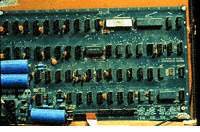|
|


 Apple I
Apple I
|
|
Computers
Steve Wozniak designed the Apple I, a single-board computer. With
specifications in hand and an order for 100 machines at $500 each from the Byte
Shop, he and Steve Jobs got their start in business. In this photograph of the
Apple I board, the upper two rows are a video terminal and the lower two rows
are the computer. The 6502 microprocessor in the white package sits on the
lower right. About 200 of the machines sold before the company announced the
Apple II as a complete computer.

|
|
|
 Cray I
Cray I
|
|
Computers
The Cray I made its name as the first commercially successful vector processor.
The fastest machine of its day, its speed came partly from its shape, a C,
which reduced the length of wires and thus the time signals needed to travel
across them.
| Project started: |
1972 |
| Project completed: |
1976 |
| Speed: |
166 million floating-point operations per second |
| Size: |
58 cubic feet |
| Weight: |
5,300 lbs. |
| Technology: |
Integrated circuit |
| Clock rate: |
83 million cycles per second |
| Word length: |
64-bit words |
| Instruction set: |
128 instructions |

|
|
|
 Hirose's Soft Gripper
Hirose's Soft Gripper
|
|
Robots & AI
Shigeo Hirose's Soft Gripper could conform to the shape of a grasped object,
such as this wine glass filled with flowers. The design Hirose created at the
Tokyo Institute of Technology grew from his studies of flexible structures in
nature, such as elephant trunks and snake spinal cords.

|
|
|
 CP/M
CP/M
|
|
Software & Languages
Gary Kildall developed CP/M, an operating system for personal computers.
Widely adopted, CP/M made it possible for one version of a program to run on a
variety of computers built around eight-bit microprocessors.

|

|
|

|
|
